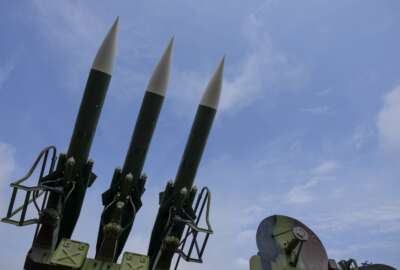How the Army will make sure it has the people to staff its modernized organic factories
"The Federal Employee Viewpoint Survey is one of the key ways that we measure the pulse of the workforce," said Christina Freese.
We just heard from the director of the task force that’s modernizing the Defense Department’s organic industrial base. Modernized factories and depots need people with modernized skills. For how its handling that task, the Federal Drive with Tom Temin spoke with the deputy chief of staff for personnel at the Army Materiel Command, Christina Freese.
Interview transcript:
Christina Freese In Army Materiel Command we have about 165,000 total workforce, and that is the combination of our contractor support teammates, as well as the civilian and military members, which are about 90,000 of those personnel. And of the army, civilian and military, we are 95% civilian.
Tom Temin Wow. So then you are also listed as a good place to work, which measures civilian workforce attitudes? And so it must seem a little bit removed from the Army without many uniforms around. And yet it’s considered a great place to work by the employees. What’s going on? What’s the magic?
Christina Freese Yeah. Thank you for that. So we worked so very hard in Army Materiel Command to make sure that our workforce is engaged. The Federal Employee Viewpoint Survey, of course, is one of the key ways that we measure the pulse of the workforce. What is going well and what we need to improve. We influence our civilian implementation plan with that feedback so that we create actions that help us to continue to improve the employee engagement, as well as making sure that we are offering workplace flexibilities that are meaningful to the workforce as we balance those things with our mission.
Tom Temin And are you scattered geographically?
Christina Freese Yes. We are in all 50 states and we have people in 150 countries around the world. So I think Army Materiel Command (AMC) is one of the most diverse workforces inside the Army, because we have such a large footprint and our mission is so rapidly changing in dynamic.
Tom Temin And in those workplace flexibilities, do you have flexibility from location to location depending on what local conditions might be?
Christina Freese So we do have expeditionary workforce that go to work in different locations and forward repair teams. And as the mission around the world dictates.
Tom Temin Well, what I mean is, say telework policy is something that would vary from place to place. You’ll give that local discretion for all the places that you operate in.
Christina Freese That is exactly how we do it, because our mission is so different in different organizations within our command. We have a variety of telework. Some people telework one day a week, multiple days a week. There are a few positions that cannot telework based on their duties, but we also have our remote workforce.
Tom Temin And how much of the workforce interaction is with the services that are needing what you deliver, how much you interact with DLA, that you kind of have an allied mission, but you try not to overlap, I’m presuming. And then with the contractor base that you’re acquiring from.
Christina Freese Right. So we definitely interact with DLA, with all of the Army, with the other services. We offer a unique mission with the rest of the military services, as well as foreign military sales and security assistance.
Tom Temin Yeah. So you need a range of skills. What’s the hardest to find? What’s the essential skill or skill set you’re looking for these days?
Christina Freese So being the sustainment command that we are, we have more logisticians than any other job series, which that is of course, critical. That is supply chain transportation, as well as the industrial arts. But we also require wrap around skills in high numbers like contracting, finance and audit, as well as cyber IT. And almost everyone, either now or in the next few years is going to be able to use data analytics. It’s just going to be required.
Tom Temin We’re speaking with Christina Freese. She’s deputy chief of staff for personnel at the Army Materiel Command. And you mentioned the organic industrial base and industrial artists, and that’s an area of focus workforce wise, isn’t it, as it is generally?
Christina Freese Yes, absolutely. So what’s special about the organic industrial base is the majority of that workforce of probably over 20,000, although it does fluctuate, are in the federal wage system or wage grade employees. So in the civilian workforce that is a niche and they have industrial arts skills, welders, painters, metrology, so many of those skills. And so as the Army is transforming and modernizing its equipment, we are doing the same at those facilities, and it includes the people. So we are reskilling and upskilling and training that workforce to be ready for that modernized equipment to come in the next few years.
Tom Temin So in the same sense that government agencies compete with the private sector for people like cybersecurity or AI people, you’re also competing, because some of those arts welding and so forth are really in high demand industrially and can command pretty good salaries?
Christina Freese Yes, absolutely. We are doing what we can with incentives to recruit and retain with special incentives, as well as establishing special salary rates for some of those. We do have high attrition, we are monitoring that and focusing our recruitment and retention efforts accordingly.
Tom Temin Are there internships or apprenticeship opportunities to bring people in very young that might give you five, 10, 12 years at least, and then maybe move on to industry?
Christina Freese Yes, we have apprenticeships that start to pull the workforce in from high school and college as well as adult learners. We bring them in.
Tom Temin Yeah, that’s kind of a sell and explaining job, because you’re recruiting for the Army, but not for soldiers.
Christina Freese Yes. One of the things that we’re really excited about is we are establishing an organic industrial base skill bridge program, which is a program that exists already in the DoD and the Army for soldiers transitioning out to find other jobs. Normally those jobs are with industry, but we were establishing a pipeline for them to come into the industrial base to continue to serve our Army, even though they’re civilian.
Tom Temin And what about people that might be leaving the Army, newly minted veterans, because that might be a path for them that other than working in an office somewhere. VA can only order so many people.
Christina Freese Yes. So we use USA jobs to hire, but we also use direct hire authority because it accelerates our ability to hire. And we can target veterans and other special skill sets. So about a third of our workforce are actually veterans. So that is a significant part of the AMC story.
Tom Temin And to a larger extent than, say, federal and military office jobs. The quote unquote office jobs for the organic industrial base. You’ve really got to keep those up to date with respect to the numerical equipment and 3D printing and all the stuff, because that’s what they’re going to encounter in the private sector.
Christina Freese Yes, absolutely. So the Army has an organic industrial base modernization plan that includes the equipment, the facilities, the tooling, cyber industrial control networks and the people.
Tom Temin Because I’ve seen some hundred year old equipment operating, and some of the organic industrial base shops. And it’s fun, but it’s time to replace it.
Christina Freese It is. And in that 15 year plan, that is exactly what the Army is doing.
Copyright © 2025 Federal News Network. All rights reserved. This website is not intended for users located within the European Economic Area.
Tom Temin is host of the Federal Drive and has been providing insight on federal technology and management issues for more than 30 years.
Follow @tteminWFED






